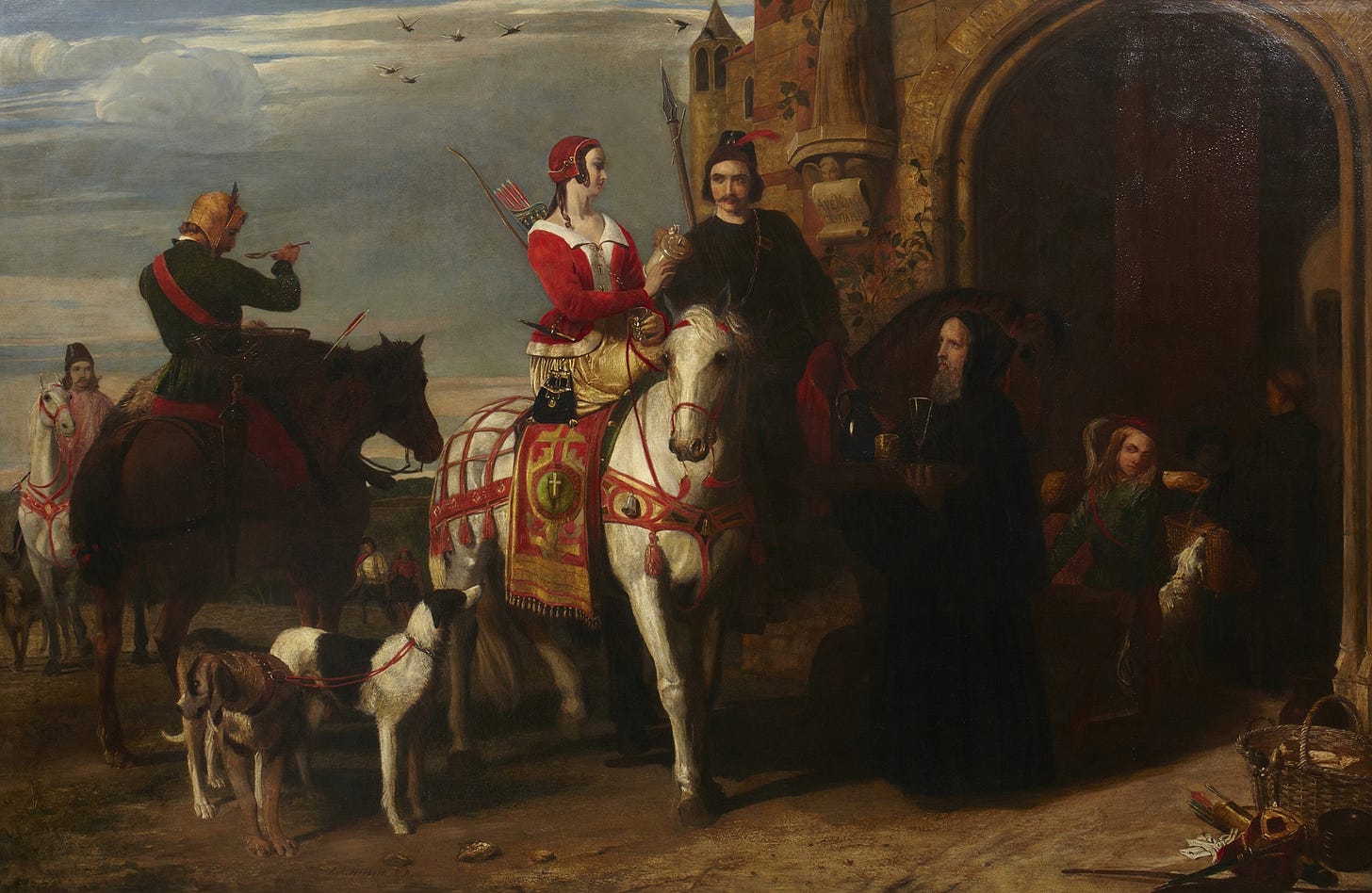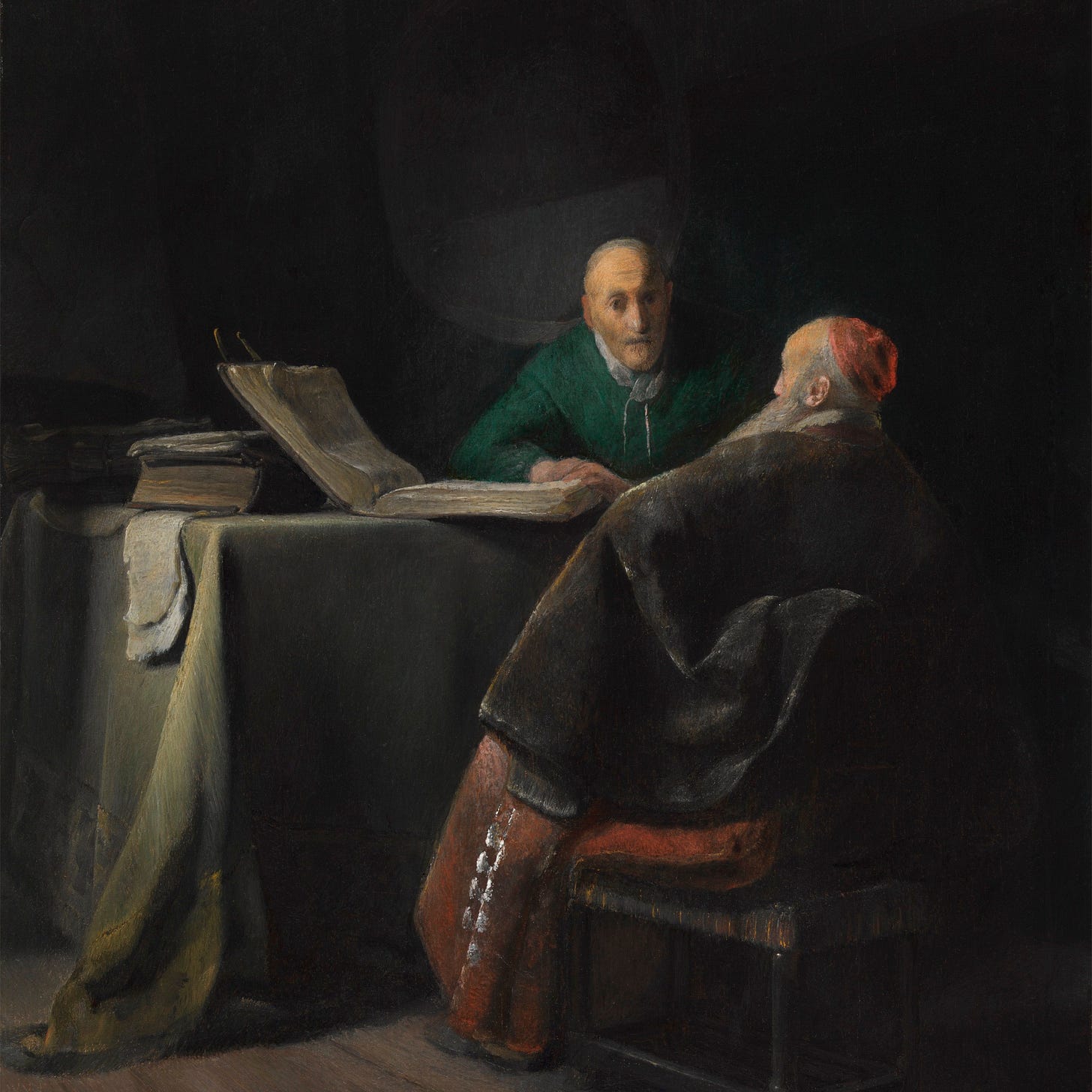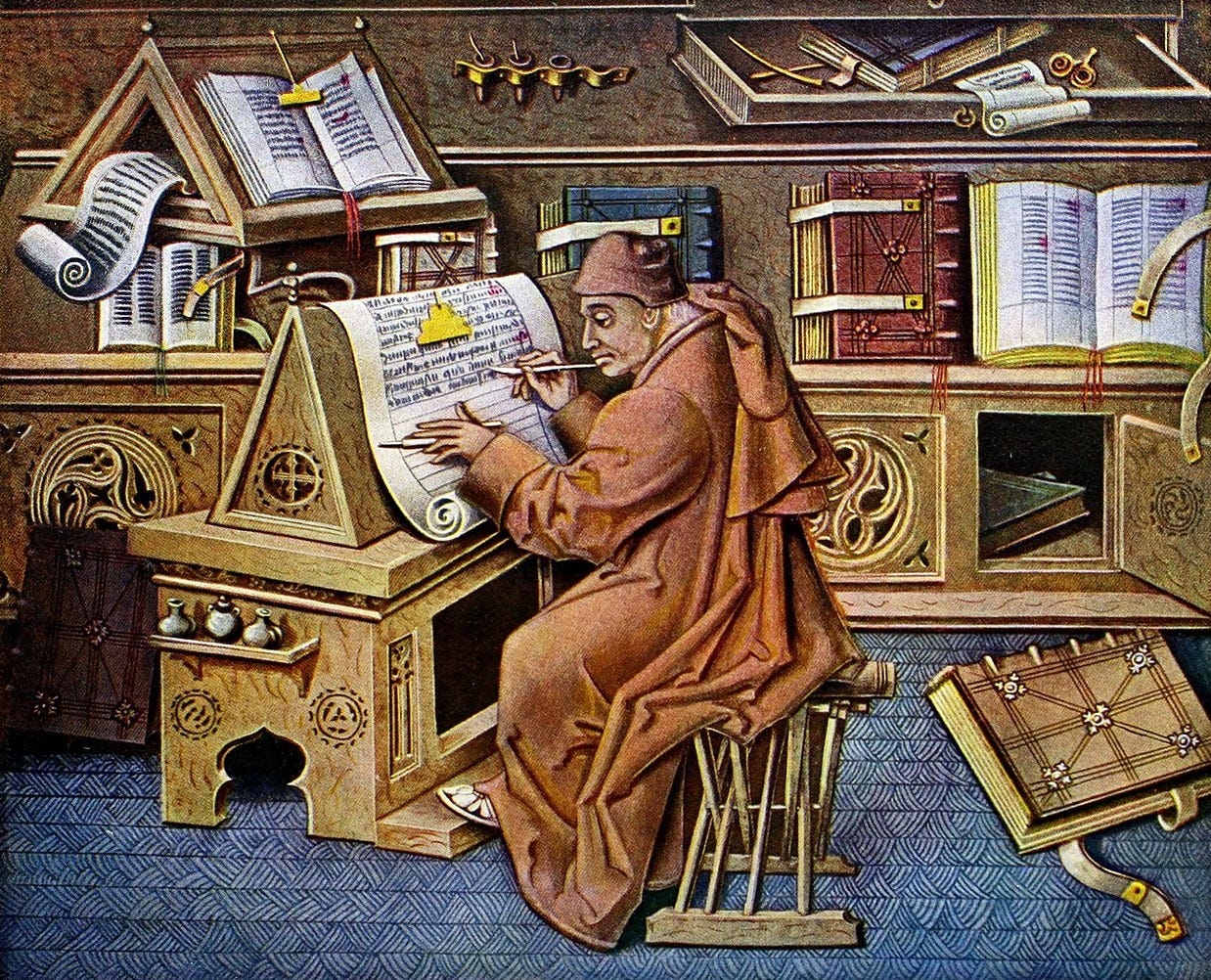The first English-speaking pope
The lost language of Adrian IV (1100-1159)
Rome, late June, AD 1155.
The heat of the Roman summer presses like a shroud. Flies circle near the high, arched window, colliding uselessly against the sun-baked glass.
Pope Adrian IV sits in one of his private chambers in the Lateran Palace, where popes have lived since the days of Constantine. But no amount of opulence can make the sun relent. Even this late in the day, it oppresses both man and beast.
The white linen Adrian wears is dampened with sweat, as are his palms against the carved armrest. His thick fingers grip the wood tightly. One of those fingers is adorned with the Fisherman’s Ring.
From across the table, John of Salisbury leans forward. He has spent months here as a guest, an advisor, a countryman. A friend.
The day’s work is done, but neither man is satisfied.
Adrian swirls wine in his goblet. He looks not at Salisbury, but at the flame of the candle a servant has brought out to replace the light of the fast-setting sun. He looks older tonight than his fifty-five years. Perhaps it’s the weight of papal responsibility settling over him, now that he’s lived a year under its burden.
Or perhaps it’s the conversation he now has to have.
“King Henry,” Adrian begins, his voice soft, his Latin smooth and practised, “has written to me again.”
Salisbury waits expectantly.
Adrian continues, “He remains displeased with you, John.”
Salisbury’s eyes fall to his own goblet, still untouched. “The King is young. Young and foolish.”
“And yet still King of England.”
Salisbury does not speak.
“He has read your writings. Are you so foolish as to imagine that a king would favour a man who has argued that tyrannical rulers may justly be overthrown?”
“But it is just,” Salisbury shoots back. “And a King who would have the Church bow to him — is there a better word for that than ‘tyrant’?”
Now it is Adrian’s turn to fall silent.
“My service is to the Church. To the Archbishop of Canterbury, and to you, Holy Father. And I could perform that service so much better as a cardinal.”
Adrian sighs. He looks at John a moment, before speaking — in English: “I know your worth, John. The Church needs you. If the choice were mine alone—”
Salisbury interjects, also in English — “But Nicholas, the choice is yours!”
In their shared language, the two friends can speak more freely.
“I cannot face the world alone, my friend,” says Adrian. “The Germans fight me at every turn. And of course, the Romans themselves would oppose another foreigner. But more than anything, I need allies in England more than in Rome.”
Salisbury sinks into his chair, the hope draining from his face as he realizes that his friend Nicholas Breakspear is no more — he has been wholly replaced by this Adrian IV.
“I see,” he says, switching back to Latin.
“Do not worry, John. There will be other chances. These matters take time. Perhaps in a few years, King Henry will relent and come to be a friend of the Church.”1
The men don’t know it, but there will be no other chances. Pope Adrian IV will die in 1159. And English would never be spoken again as a native language by anyone holding the papal office.
That is, until almost 900 years later, when Pope Leo XIV — an American-born Peruvian citizen — is elected to the papacy.
That is quite the interval! Between the first and second native English-speaking popes, the English language has changed a great deal.
In fact, Adrian’s papacy lay right on the border of two of the major periods of the English language: Old English (450–1100) and Middle English (1100–1450).
So what was English like when Adrian IV spoke it in the 12th century? Was he a native speaker of Old or Middle English? And why should we even care?
You're reading The Dead Language Society. I'm Colin Gorrie, linguist, ancient language teacher, and your guide through the history of the English language and its relatives.
Subscribe for a free issue every Wednesday, or upgrade to support my mission of bringing historical linguistics out of the ivory tower and receive two extra Saturday deep-dives per month.
From St Albans to St Peters
To understand Adrian IV’s English, we first have to consider the context he was born into.
Adrian, or Nicholas Breakspear, to use the name he started out with, was born around the year AD 1100. This was a mere 34 years after the Norman conquest, and a time of great change in England.
Many people alive during Breakspear’s lifetime would have been born before the coming of the Normans, growing up in a world where English was the language of government and the elite.
Not much is known about Breakspear’s early life, although he was likely born near the town of St Albans in Hertfordshire. Legend has it that he was too poor to have received much of an education, and, as a result, was turned away from the Abbey of St Albans when he sought entry as a novice.
If indeed Breakspear was turned away from St Albans, he didn’t let it slow him down. History next catches up to him in Arles, in the south of France, where he studied canon law. After he graduated, he rose quickly in the church, becoming abbot of St Ruf in 1137.
It seems that Abbot Breakspear was too strict for the monks under his supervision, and, facing a rebellion, he was summoned to Rome to explain himself. Despite further trouble with the monks and further trips to Rome to sort things out — or perhaps because of his reputation as a strict disciplinarian — Breakspear came to the attention of Pope Eugene III.
It’s not entirely clear why, but Eugene took a liking to Breakspear — or at least found him useful. And Breakspear continued his ascent. In 1149, Eugene appointed Breakspear Cardinal-Bishop of Albano, one of the highest offices in the Church, and well within the Pope’s inner circle.
Breakspear was sent by the Pope in 1152 on a mission to Scandinavia, which was a success. Landing in Norway, he brought peace to the factions fighting a civil war; from there, he sailed to Sweden, where he firmly subordinated the Swedish Church to Rome.
Returning home in late 1154, however, he found that his benefactor Eugene III had died the year before, and so had his successor, Athanasius IV, just weeks before Breakspear’s return to Rome: as a result, the top job was now open.
Coming fresh from such a triumph in Scandinavia, the choice before the cardinals was clear: Breakspear was elected unanimously and took the name Adrian IV.
His papacy was short and turbulent, owing to some major conflicts: one such crisis set Adrian against the people of the city of Rome, who had fallen under the sway of a radical preacher named Arnold of Brescia. Brescia criticized the worldly power of the Church, and was dealt with by calling in the Holy Roman Emperor Frederick Barbarossa, who drove Arnold out of Rome for Adrian.
This led to the second great trial of Adrian’s papacy, which was the unending power struggle between Adrian and Barbarossa: neither was willing to subordinate himself to the other, although neither could entirely do without the other.
This conflict between the Church and the secular rulers would not only last through Adrian’s papacy, but would intensify in the decades to come, becoming one of the major political themes of the later Middle Ages.
Pope Adrian IV died in 1159, likely just under the age of 60. His remarkable life spanned the first half of the 12th century, an era that saw deepening conflict between Church and State, which Adrian himself proved unable to forestall.
While Adrian spent most of his life outside of England, his formative years would have been spent in Hertfordshire — and this is where he would have learned his first language, English.
A language in transition
As a child of the early 12th century, Adrian IV would have spoken an English that was transitioning from the Old English of Beowulf to the Middle English of Chaucer. Scholars tend to mark the end of Old English in one of two places: either in 1066, with the Norman Conquest, or around 1100–1150, when the last of the English-speakers living before the conquest had passed away. However you slice it, Adrian IV lived very close to the dividing line.
In reality, these divisions are arbitrary: Old English didn’t become Middle English overnight in 1066, 1100, or 1150. Instead, the transition between Old and Middle English was gradual.
Even so, Adrian would have had a front-row seat to that transition. Old English — the English of Beowulf, King Alfred, and Adrian’s grandparents — was what linguists call a synthetic language. This means that word endings did a lot of the grammatical heavy lifting. Endings on nouns told you who was doing what to whom, and endings on verbs told you when something was done, and by whom.
For example, in the following sentences, look at the difference between the forms for the word bera ‘bear.’ When the bear is doing the seeing, it looks like this: bera, with the ending -a. But when the bear is being seen, it changes to beran, with the ending -an.
bera ġeseah mūs
‘a bear saw a mouse’
mūs ġeseah beran
‘a mouse saw a bear’
This also means that you can have more flexible word order, because you know who is doing what from the word endings. So in this sentence, even though bera comes at the end, it’s still the bear who is doing the seeing, because bera ends in -a, and not -an.
mūs ġeseah bera
‘a bear saw a mouse’
By Adrian’s time, however, English word endings had been receding in importance, and in many cases, falling away altogether. Since endings are, by definition, at the end of the word, and most English words had their accent (or stress) at the beginning, the sounds in the word endings got muddled over time. Often, the sounds got dropped altogether.
When all of the endings start to sound the same, the information you expressed using endings needs to be conveyed some other way. One way of doing this is by fixing the word order. This is why, today, a bear saw a mouse and a mouse saw a bear mean completely different things.
Languages which don’t make much use of endings, and instead rely on word order, are called analytic. You should think of synthetic vs analytic languages as a spectrum. Old English was a fairly synthetic language, while Modern English is much more analytic. The big shift between the two came about in Middle English, and was well in progress during Adrian’s lifetime.
Adrian’s English

We don’t have any of Adrian’s writings in English — English wasn’t a language prestigious enough to write in, at least not for popes. But we can get an idea of what Adrian’s English would have been like by looking at one of the texts that was written down in his lifetime: the Peterborough Chronicle.
The Peterborough Chronicle is one of the Anglo-Saxon Chronicles, collections of historical documents kept by monasteries in England. As the name “Anglo-Saxon” suggests, most of the content of the Chronicles was written before the Norman Conquest — and written in Old English. After the Norman Conquest, most monasteries stopped updating their copies, but the monks at Peterborough Abbey kept writing down what happened to them.
Here’s an excerpt from an entry from 1140, within Adrian IV’s lifetime:
Þerefter in þe lengten þestrede þe sunne 7 te dæi. abuton non tid dæies. þa men eten. ðæt me lihtede candles to æten bi... wæron men suythe ofwundred.
(Peterborough Chronicle, 1140)
‘After this, in the spring, the sun and the day darkened about the ninth hour of the day, when people were eating; and one lit candles to eat by… People were very amazed.’
I want to zoom in on one phrase, which shows the direction English was heading in the 12th century.
That phrase is in þe lengten. By the way, that ‘þ’ is a ‘th’ — more on that next week!
The phrase in þe lengten means ‘in the spring’ — the word lengten or lencten was originally a word for spring, when the days are lengthening. It eventually came to be used for a period of time in the Christian calendar that takes place in the spring, that is, Lent.
Let’s compare it to the kind of English written 150 years earlier by Ælfric of Eynsham (circa AD 990–1010). In his Lives of Saints, Ælfric wrote on þam… lenctene.2
Let’s compare the two side by side:
Ælfric of Eynsham: on þam lenctene
Peterborough Chronicle: in þe lengten
The first difference we see is the use of in vs on. This is actually not a difference between Old and Middle English, but a difference in dialect. The West Saxon dialect that makes up the typical Old English written in Ælfric’s time used on wherever we’d use in today.
The Middle English of the Peterborough Chronicle, however, is written in an East Midland dialect. This dialect did make a distinction between in and on — and so did the dialect which gave birth to Modern English, which is why we say in the bag but on the table.
But the more interesting differences are in the other two words: for ‘the spring,’ Ælfric’s Old English has þam lenctene and the Peterborough Chronicle has þe lengten.
The -m at the end of Ælfric’s version of ‘the’ is a good example of those word endings I mentioned earlier. This ending is a marker of something called the dative case — what this means isn’t overly important for our discussion here, but it’s a form of words that is used after many prepositions, including in/on.3
This is also why there’s an -e on the end of lenctene in Ælfric’s Old English. A final -e was the dative ending on a noun like lencten. But, by the 12th century, this -e ending had started to disappear in phrases like on þam lenctene → in þe lencten.
And the special dative marking on the article was also disappearing: instead, the article was consistently just þe, or, as we’d spell it, the.4 This erosion of word endings was a major step that English took along the road to becoming an analytic language. And it was all happening in Adrian IV’s lifetime.5
May you live in transitional times
So, if Adrian IV’s speech was at all like the language of the later years of the Peterborough Chronicle, you would say he spoke a very early form of Middle English. But you’d want to add this: Pope Adrian IV lived through a time of transition between two major forms of the language.
12th-century English no longer sounded or acted like it did when the great writers of the Old English period were writing. Neither did it sound like it would when Chaucer, centuries later, would compose the Canterbury Tales.
But the secret is: we all live in times of transition. The English language — and all living languages — are constantly changing. Think of how much slang has changed over the past 50 years: even millennials, who once baffled their boomer parents, are now in turn mystified by what comes out of the mouths of their own kids: generation alpha.
The reason we make such a big deal of the transition that was going on in Adrian’s time is that we’re accustomed to thinking of English as existing in three big periods: Old English, Middle English, and Modern English.
But that’s only a convenient lens we use to look at what is really a continuous history: we focus on these three idealizations because they’re associated with famous works of literature: Beowulf and the works of Ælfric for Old English, and The Canterbury Tales for Middle English. Adrian’s time, by contrast, saw relatively little written English, so we know a lot less about it. As a result, it seems to us mysterious and transitional.
If the linguists of the future aren’t able to access the internet or read our digital documents, they may consider our English a mysterious, transitional period, too. So do them a favour and go carve “I was here when Pope Leo XIV was elected” into something more durable than digital files — just in case.
Ælfric has the adjective halgan ‘holy’ between the two words: on þam halgan Lenctene ‘in the holy Lent’. We can ignore the adjective here to get an apples-to-apples comparison.
That’s a simplified description of what the dative does. I’ve got lots more on the dative and the other cases of Old English in this article.
The singular form was þe. The plural form was different: þa. You can see an example of this in the phrase þa men ‘the people’ in the entry from 1140.
This process wasn’t happening everywhere in England at the same rate. The use of þe we see in the Peterborough Chronicle became general in written English in the 13th century.






Interestingly, the Dutch word for spring still is lente.
Great article! It's a good reminder that languages are never really static but constantly changing in at least some ways. I think it's fascinating how sound changes over time can force other changes in a language (much like Latin changed into modern Romance languages over time and lost much of its declension system for nouns).